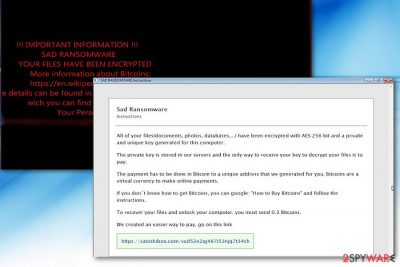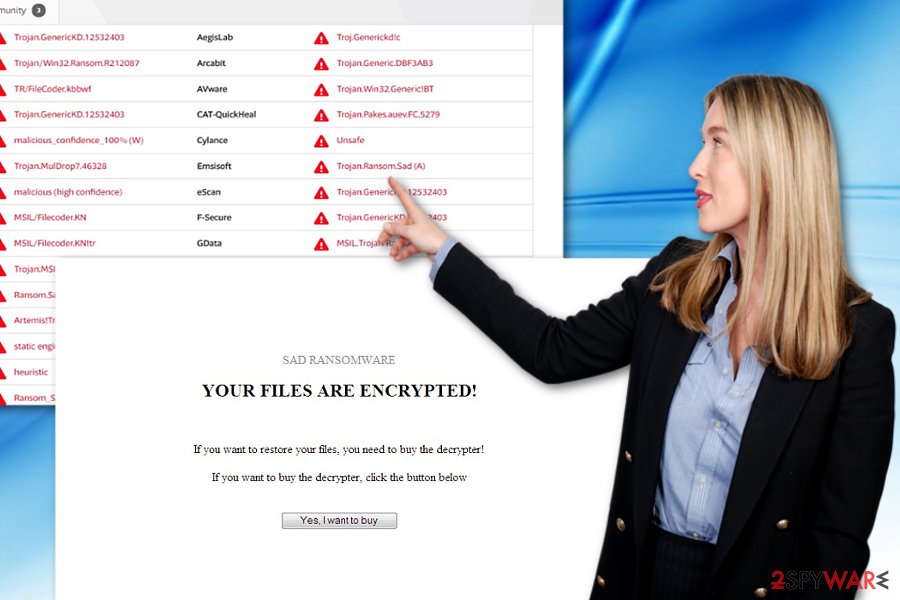Sad ransomware / virus (Virus Removal Guide) - Virus Removal Guide
Sad virus Removal Guide
What is Sad ransomware virus?
Sad hackers release Sad ransomware

Sad virus defines crypto-malware which encodes data and demands ransom 0.3 BTC in exchange to the decryption software called decrypter.exe.[1] The latter is available on a specific website accessible via Tor browser.
During the infiltration, the malware drops the following files[2]:
- _HELPME_DECRYPT_.txt
- _HELPME_DECRYPT_.hta
- _HELPME_DECRYPT_.html
All of them display a slightly different message. The .txt file includes the link to the general information about bitcoins and ways to purchase them.
The .hta file states that the data has been encoded using AES-256 cipher. According to the style of the message, the developer seems to be a non-native English speaker. The file also includes Tor link to the decrtypter.exe – the tool to decode the data affected by Sad ransomware.
Furthermore, the .html file displays less information and urges victims to purchase the decryption software. The malware also leaves picture.exe file in Shared folder.
The malware is already detectable by the majority of security tools as MSIL.Trojan-Ransom.Sad.A, Ransom.Sad, Ransom.CryptXXX, Ransom_SAD.A , etc. The malware seems to disguise under tGVkDTIb.exe file, though executable files may vary.
The malware appends an extension comprised of random hexadecimal characters. There is no information whether Sad Decryptor functions properly. Instead of paying the ransom, concentrate on the elimination of the malware. FortectIntego or Malwarebytes will help you complete Sad removal.
Ransomware distribution trends
Usually, trojanized ransomware might be foisted as rogue applications in highly dubious websites, such as gaming, gambling, and sites with adult content.
Alternatively, some ransomware developers prefer using exploit kits and hide their malware under fake Adobe Flash Player update[3]. Do not forget that spam emails also remain a popular distribution method.
In order to limit the risk of Sad hijack, pay attention to the programs and source you download from. Be wary of spam emails which are supposedly sent by the official institutions. Installing a couple of different type anti-malware tools might be practical as well. They will help you evade websites infected with exploit kits or phishing sites promoting counterfeited software updates. Let us move on Sad ransomware removal. 
Sad elimination steps
Though the malware has quite sufficient GUI and operation mode, it is not known whether it deletes shadow volume copies and causes Sad removal troubles. If the anti-virus program does not respond, restart the system in Safe Mode.
Later on, you should be able to launch the security tool and eliminate the malware. Only after you remove Sad virus completely, proceed to data recovery. There is also an additional method which helps you access the operating system. Not only English users should be wary of the malware, but other users residing in the Czech Republic, Bulgaria[4], or Spain.
Getting rid of Sad virus. Follow these steps
Manual removal using Safe Mode
Important! →
Manual removal guide might be too complicated for regular computer users. It requires advanced IT knowledge to be performed correctly (if vital system files are removed or damaged, it might result in full Windows compromise), and it also might take hours to complete. Therefore, we highly advise using the automatic method provided above instead.
Step 1. Access Safe Mode with Networking
Manual malware removal should be best performed in the Safe Mode environment.
Windows 7 / Vista / XP
- Click Start > Shutdown > Restart > OK.
- When your computer becomes active, start pressing F8 button (if that does not work, try F2, F12, Del, etc. – it all depends on your motherboard model) multiple times until you see the Advanced Boot Options window.
- Select Safe Mode with Networking from the list.

Windows 10 / Windows 8
- Right-click on Start button and select Settings.

- Scroll down to pick Update & Security.

- On the left side of the window, pick Recovery.
- Now scroll down to find Advanced Startup section.
- Click Restart now.

- Select Troubleshoot.

- Go to Advanced options.

- Select Startup Settings.

- Press Restart.
- Now press 5 or click 5) Enable Safe Mode with Networking.

Step 2. Shut down suspicious processes
Windows Task Manager is a useful tool that shows all the processes running in the background. If malware is running a process, you need to shut it down:
- Press Ctrl + Shift + Esc on your keyboard to open Windows Task Manager.
- Click on More details.

- Scroll down to Background processes section, and look for anything suspicious.
- Right-click and select Open file location.

- Go back to the process, right-click and pick End Task.

- Delete the contents of the malicious folder.
Step 3. Check program Startup
- Press Ctrl + Shift + Esc on your keyboard to open Windows Task Manager.
- Go to Startup tab.
- Right-click on the suspicious program and pick Disable.

Step 4. Delete virus files
Malware-related files can be found in various places within your computer. Here are instructions that could help you find them:
- Type in Disk Cleanup in Windows search and press Enter.

- Select the drive you want to clean (C: is your main drive by default and is likely to be the one that has malicious files in).
- Scroll through the Files to delete list and select the following:
Temporary Internet Files
Downloads
Recycle Bin
Temporary files - Pick Clean up system files.

- You can also look for other malicious files hidden in the following folders (type these entries in Windows Search and press Enter):
%AppData%
%LocalAppData%
%ProgramData%
%WinDir%
After you are finished, reboot the PC in normal mode.
Remove Sad using System Restore
If Safe Mode method is not convenient to you, you may perform System Restore. In order for it to complete successfully, you may need to disable or delete anti-virus tool. After the procedure, reinstall it again. If necessary, change the name of the executable so that the malware would not interfere with its process.
-
Step 1: Reboot your computer to Safe Mode with Command Prompt
Windows 7 / Vista / XP- Click Start → Shutdown → Restart → OK.
- When your computer becomes active, start pressing F8 multiple times until you see the Advanced Boot Options window.
-
Select Command Prompt from the list

Windows 10 / Windows 8- Press the Power button at the Windows login screen. Now press and hold Shift, which is on your keyboard, and click Restart..
- Now select Troubleshoot → Advanced options → Startup Settings and finally press Restart.
-
Once your computer becomes active, select Enable Safe Mode with Command Prompt in Startup Settings window.

-
Step 2: Restore your system files and settings
-
Once the Command Prompt window shows up, enter cd restore and click Enter.

-
Now type rstrui.exe and press Enter again..

-
When a new window shows up, click Next and select your restore point that is prior the infiltration of Sad. After doing that, click Next.


-
Now click Yes to start system restore.

-
Once the Command Prompt window shows up, enter cd restore and click Enter.
Bonus: Recover your data
Guide which is presented above is supposed to help you remove Sad from your computer. To recover your encrypted files, we recommend using a detailed guide prepared by 2-spyware.com security experts.If your files are encrypted by Sad, you can use several methods to restore them:
What is Data Recovery Pro?
This program was designed to recover damaged data after a system crash. If you do not have backup copies, try this method.
- Download Data Recovery Pro;
- Follow the steps of Data Recovery Setup and install the program on your computer;
- Launch it and scan your computer for files encrypted by Sad ransomware;
- Restore them.
What is “Windows Previous Versions” function?
If System Restore function is enabled, you may benefit from this method as well. Note that you will have to go through each file manually.
- Find an encrypted file you need to restore and right-click on it;
- Select “Properties” and go to “Previous versions” tab;
- Here, check each of available copies of the file in “Folder versions”. You should select the version you want to recover and click “Restore”.
The benefits of ShadowExplorer
This tool uses shadow volume copies to recreate the copies of the original documents. Sad ransomware does not seem to delete them, likewise, you may stand a chance.
- Download Shadow Explorer (http://shadowexplorer.com/);
- Follow a Shadow Explorer Setup Wizard and install this application on your computer;
- Launch the program and go through the drop down menu on the top left corner to select the disk of your encrypted data. Check what folders are there;
- Right-click on the folder you want to restore and select “Export”. You can also select where you want it to be stored.
Finally, you should always think about the protection of crypto-ransomwares. In order to protect your computer from Sad and other ransomwares, use a reputable anti-spyware, such as FortectIntego, SpyHunter 5Combo Cleaner or Malwarebytes
How to prevent from getting ransomware
Choose a proper web browser and improve your safety with a VPN tool
Online spying has got momentum in recent years and people are getting more and more interested in how to protect their privacy online. One of the basic means to add a layer of security – choose the most private and secure web browser. Although web browsers can't grant full privacy protection and security, some of them are much better at sandboxing, HTTPS upgrading, active content blocking, tracking blocking, phishing protection, and similar privacy-oriented features. However, if you want true anonymity, we suggest you employ a powerful Private Internet Access VPN – it can encrypt all the traffic that comes and goes out of your computer, preventing tracking completely.
Lost your files? Use data recovery software
While some files located on any computer are replaceable or useless, others can be extremely valuable. Family photos, work documents, school projects – these are types of files that we don't want to lose. Unfortunately, there are many ways how unexpected data loss can occur: power cuts, Blue Screen of Death errors, hardware failures, crypto-malware attack, or even accidental deletion.
To ensure that all the files remain intact, you should prepare regular data backups. You can choose cloud-based or physical copies you could restore from later in case of a disaster. If your backups were lost as well or you never bothered to prepare any, Data Recovery Pro can be your only hope to retrieve your invaluable files.
- ^ Leo. "Sad" Ransomware. plays a short beep, encrypts your files. Twitter. Online Source for Communication and News.
- ^ Michael Gillespie . Sad ransomware pastebin files. Twitter. Online Source for Communication and News.
- ^ Raymond Wong. This is the most diabolical Android ransomware we've ever seen. Mashable, IT News and Commentary.
- ^ get rid of computer malware. Virusi. Security and spyware news in Bulgarian.





















